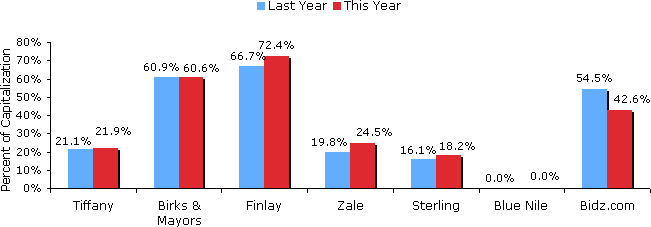IDEX Online Research: U.S. Jewelers’ Debt Levels Up in First Quarter
July 29, 07
Primarily as a result of higher inventory levels and lower cash levels, both of which are related to below-plan sales, many jewelers reported that their debt levels were up moderately at the end of the first quarter of 2007. As a result of higher debt levels, coupled with slightly higher interest rates, profits were adversely affected in the quarter.
The following graph illustrates debt levels on a year-over-year basis. These debt levels include both short term and long term debt of all kinds.
| Jewelers' Debt Levels Mostly Up |
GUILD JEWELERS
Debt levels for the guild jewelers generally moved in unison with inventory levels.
Tiffany & Co. – Tiffany’s debt levels, while very moderate, rose slightly in the quarter.
- During the first quarter, total debt to total capitalization rose to 21.9 percent from 21.1 percent last year. Most of this increase was due to financing higher inventory levels related to new store openings.
- The company’s customer receivables rose by a very moderate 4 percent, and continue to turn at about 18 times annually. Thus, they did not account for any notable portion of the company’s increased debt levels.
Harry Winston – Harry Winston does not report specific debt levels related solely to its retail business.
Birks & Mayors – Total debt to total capital was almost flat at 60.6 percent capitalization this year versus 60.9 percent last year.
- Short term debt was up to support a higher inventory level and a lower level of vendor payables.
- Long term debt was about flat.
- Shareholders’ equity rose sharply by 21 percent during the year; this helped keep the debt ratio in line, despite higher levels of borrowing.
Movado Boutiques – Movado is one of the few jewelers to report that its debt levels declined in the first quarter versus the same period last year. On a corporate basis, total debt was 17.0 percent of capitalization, down from 23.9 percent last year. Management focuses very closely on cash management and wise use of working capital.
MASS MARKET FASHION JEWELERS
Debt levels among the mass market fashion jewelers remained generally well-controlled in the first quarter.
Finlay Enterprises – Finlay’s total debt rose to 72.4 percent in the quarter, up from last year’s 66.7 percent. Finlay has historically carried among the highest debt level of any publicly held jewelers in the American market. The following factors had an impact on debt levels.
- The company took on additional debt to acquire the Congress jewelry chain late last year.
- The company has a much higher ratio of owned inventory to consignment inventory this year, primarily related to closing out its gold lease arrangements last year.
Stering Jewelers – Total debt levels rose modestly at Signet Group, but remain among the low end of the range for U.S. jewelers. At the end of the quarter, Signet’s total debt was 18.2 percent of total capitalization, up from last year’s 16.1 percent. The company does not break out debt levels by operating division (U.S. 78% of sales; U.K. 22% of sales).
Zale Corporation – Long term debt to total capital rose from 24.5 percent in the quarter versus 19.8 percent in the same quarter a year ago.
- Zale management says it will have negative free cash flow this year of $70-80 million due to four factors:
- A lower level of payables related to less restocking of merchandise.
- Higher inventory levels.
- Lower sales and profits.
- Direct sourcing will use cash.
ONLINE JEWELERS
Store-based jewelers absolutely must examine the business model of the online jewelers. None of these jewelers has any long term debt. Period. Nada. None. It can be done: take a look at Blue Nile, Abazias, and Bidz.com.
Blue Nile – Blue Nile has no debt. It relies on consignment goods for its sales.
Abazias – The company has no long term debt, though it has about $51,000 in short term debt related to a note payable and a loan from a shareholder.
- Abazias’ total debt (all short term loans) to capital declined to 26.0 percent at the end of the first quarter, versus 27.6 percent at the end of the first quarter of 2006.
Bidz.com – The company has no long term debt. However, it appears to use vendor payables to finance its operations; vendor payables rose 186 percent over last year. It also has the ability to borrow on a short term basis via a revolving credit line.
